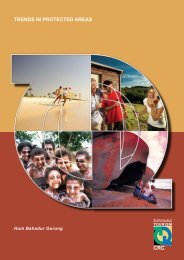icolls - Sustainable Tourism CRC
icolls - Sustainable Tourism CRC
icolls - Sustainable Tourism CRC
You also want an ePaper? Increase the reach of your titles
YUMPU automatically turns print PDFs into web optimized ePapers that Google loves.
ECOLOGY, THREATS AND MANAGEMENT OPTIONS FOR SMALL ESTUARIES AND ICOLLS<br />
Victoria, and has the potential for national and international application. Application of this tool to estuary<br />
management will bring environmental considerations into balance with social and economic values.<br />
Title of paper: Coastal-oasis zone management. Mulege estuary region in the Gulf of California, Mexico<br />
Author: Oscar Arizpe & Angeles Cobarrubias1<br />
Author's email: oarizpe@uabcs.mx<br />
Abstract: The Mulege estuary region is located at the southeastern part of the Baja California Peninsula. The<br />
coastal-oasis and adjacent areas with an extension of 550 km2 are highly valued by local population as well as<br />
visitors from many countries, because it has been a pristine, scenic, and also a highly productive habitat in the<br />
Gulf of California. Since 2001 as a part of Gulf of California Regional Integrated Coastal Management we have<br />
conducted many specific studies to terrestrial and aquatic zoning in order to allocate environmental policies and<br />
specific uses in each zone. The former approximation with a scale of 1:25 000 were derived from ASTER<br />
imagery: False color composite for land use and digital elevation model for the micro-basins. The marine littoral<br />
zoning is an overlapping outcome from wave energy, depth and coastal geomorphology. The terrestrial zoning<br />
was derived overlapping micro-basins, terrestrial geomorphology and land use. The zoning outcomes were 19<br />
terrestrial and 14 aquatic environmental units. For the evaluation processes of the environmental units, a<br />
weighting rating technique was used for three types of policies allocations: protection, conservation and<br />
development. The evaluation is based on a set of 30 environmental and 21 socioeconomic terrestrial indicators<br />
and 13 environmental and 16 socioeconomic marine littoral indicators. The preliminary results show that the<br />
26% of the total area is recommended for the protection policy, 33% conservation and the 41% for the<br />
development policy. We developed and presented a planning process with management objectives to approach<br />
the conservation and sustainable development of this relevant coastal estuarine system.<br />
Title of paper: Important Water Quality Processes in New South Wales Coastal Lagoons<br />
Author: Philip Haines<br />
Author's email: phaines@wbmpl.com.au<br />
Abstract: The water quality of New South Wales coastal lagoons is dependent on a number of factors, including<br />
catchment runoff conditions, the behaviour of the entrance and the physical characteristics of the lagoon. Typical<br />
water quality results for New South Wales coastal lagoons have been compiled and reviewed. The results<br />
illustrate the influence of catchment development on water quality parameters, such as Total Phosphorus and<br />
Chlorophyll-a, with increasing concentrations for increasing amounts of development. Total Nitrogen on the<br />
other hand is more influenced by the dominant entrance condition of the lagoon. For lagoons that are mostly<br />
open, typical total nitrogen concentrations were lower than those lagoons that are mostly closed. Detailed water<br />
quality results for two coastal lagoons in Sydney (Dee Why Lagoon and Curl Curl Lagoon) were correlated<br />
against periods of open and closed entrance conditions between 1994 and 2003. The results show that the water<br />
quality of the lagoons changes significantly based on entrance conditions. In particular, oxidised nitrogen<br />
concentrations were notably different between periods of open and closed entrance conditions, with much higher<br />
concentrations recorded when the entrances were open. The data also shows differences in the response of the<br />
two lagoons to entrance breakout, based on their physical (morphometric) characteristics. Dee Why Lagoon,<br />
which is roughly circular in shape, was generally well flushed of chlorophyll-a by opening of the entrance. Curl<br />
Curl Lagoon, however, which is comparatively long and linear, was only flushed of chlorophyll-a in the most<br />
downstream section of the lagoon immediately adjacent to the entrance. Relatively high chlorophyll-a<br />
concentrations were maintained in the remainder of the lagoon regardless of entrance condition. Clearly these<br />
results have implications from a management perspective, as some New South Wales coastal lagoons are opened<br />
artificially in an attempt to improve water quality.<br />
Title of paper: Use of flooded margins of a stratified estuary by fish and invertebrates<br />
Author: Alistair Becker, Laurie Laurenson, Paul Jones<br />
Author's email: abeck@deakin.edu.au<br />
Abstract: The formation of a sand bar and closure to the ocean is a common feature of estuaries in temperate<br />
regions of Australia. Following closure many estuaries begin to flood providing new habitat for fish that offers<br />
cover and rich food sources. The Surrey Estuary, located in southwest Victoria, Australia, follows predictable<br />
seasonal patterns of mouth closure and flooding. The mouth of the estuary is often opened artificially if waters<br />
flood surrounding infrastructure and pastures. Being a salt wedge estuary the water column becomes highly<br />
stratified during protracted periods of the year. Following mouth closure the saline bottom water stagnates,<br />
becoming anoxic and unsuitable for ichthyofauna. The extent of flooding is a function of estuary depth, flooding<br />
is currently being mapped at a variety of depths to determine the extent of flooded areas and variations in habitat<br />
associated with flooding. As part of this process, a digital elevation model of the estuary and surrounding terrain<br />
is being developed. Fish are being sampled monthly using fyke and seine nets from both the flooded margins of<br />
54











